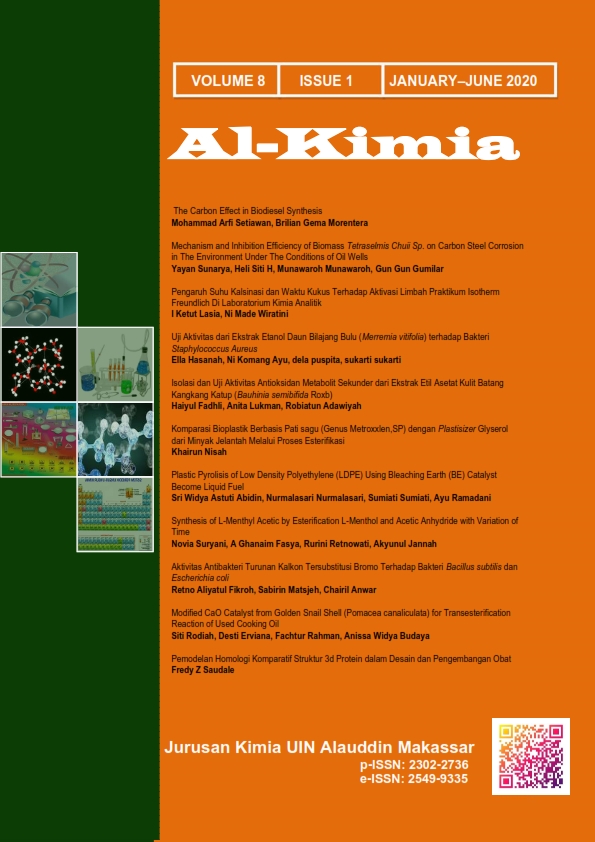Komparasi Bioplastik Berbasis Pati sagu (Genus Metroxxlen,SP) dengan Plastisizer Glyserol dari Minyak Jelantah Melalui Proses Esterifikasi
Abstrak
The results of Esterification of waste frying oil is used in this study as bioplastic plasticizers. Sago plate (Genus Metroxxlen, SP), as bioplastic matrix due to amylopectin content. This study intend to utilize waste frying oil and increase the benefits of sago as a bioplastic. The method of making bioplastics by heating 600 C. Characteristics are carried out based on the properties of mechanical properties (Tensile strength), morphology (organoleptic), functional groups (FT-IR), transparasi (UV-VIS), water resistance, and degradation. The composition made, from sago and glycerol (0.5: 1; 1: 1; 0.5: 2; 0.5: 3) produced the best bioplastic with sago composition and glycerol is 0.5: 3. Characteristics that It was observed in the form of elongation of 4.10%, tensile strength 7.08 Kgf / m2, water resistance 0.0037%, transparency of 0.086%, functional groups with absorption in the area of 2924.5 cm-1 which showed alkane compounds, namely streching CH in the area of 2850-3000 cm-1. Streching -O- ether is at 1639.05 cm-1, then the absorption at 3290.86 cm-1 is the -OH functional group absorption. Degradation on day 15 shows a greater decay yield of 34.68 mg. Surface morphology that is not smooth, due to the presence of pores and cracks, this situation is possible due to the lack of OH content in glycerol from used cooking oil.
##plugins.generic.usageStats.downloads##
Referensi
Aziz, I., Nurbayti, S., & Ulum, B. (2011). Esterifikasi Asam Lemak Bebas Dari Minyak Goreng Bekas. 2(2), 384–388.
Bertuzzi, M. A., Armada, M., & Gottifredi, J. C. (2007). Physicochemical characterization of starch based films (Vol. 82).
https://doi.org/10.1016/j.jfoodeng.2006.12.016
Flórez, N., González-Muñoz, M. J., Ribeiro, D., Fernandes, E.,
Domínguez, H., & Freitas, M. (2017). Algae polysaccharides’ chemical characterization and their role in the inflammatory process. Current Medicinal Chemistry, 24(2), 149–175.
https://doi.org/10.2174/092986732366616102
Kore, V. T., Tawade, S. S., & Kabir, J. (2016). Application of Edible Coatings on Fruits and Vegetables. (December).
Kurdi, A., Hao, W., & Chang, L. (2018). Tribological behaviour of high performance polymers and polymer composites at elevated temperature Tribology International Tribological behaviour of high performance polymers and polymer composites at elevated temperature. Tribiology International, 130(October), 94–105.
https://doi.org/10.1016/j.triboint.2018.09.010
Nisah, K. (2017). Study Pengaruh Kandungan Amilosa Dan Amilopektin Umbi-Umbian Terhadap Karakteristik Fisik Plastik Biodegradable Dengan Pendahuluan 5(2), 106–113.
Sutardi., T. dan. (1990). Biokimia dan Teknologi Pasca Panen. In Gajah Mada University Press.
Yogyakarta. https://doi.org/10.1145/2783258.2783395
Tamiogy, W. R., Kardisa, A., & Aprilia, S. (2019). Pemanfaatan Selulosa dari Limbah Kulit Buah Pinang sebagai Filler pada Pembuatan Bioplastik Utilization of Cellulose from Betel Nut Husk Waste as Filler in Preparation of Bioplastics. 14(01).
Torheim, L. E., Diarra, M., & Barikmo, I. (2004). Nutrient adequacy and dietary diversity in rural Mali : association and determinants. (March 2014). https://doi.org/10.1038/sj.ejcn.1601853
##submission.copyrightStatement##
##submission.license.cc.by-nc-sa4.footer##Authors who publish with this journal agree to the following terms:
1) Authors retain copyright and grant the journal right of first publication with the work simultaneously licensed under a Creative Commons Attribution License that allows others to share the work with an acknowledgement of the work's authorship and initial publication in this journal.
2) Authors are able to enter into separate, additional contractual arrangements for the non-exclusive distribution of the journal's published version of the work (e.g., post it to an institutional repository or publish it in a book), with an acknowledgement of its initial publication in this journal.
3)Authors are permitted and encouraged to post their work online (e.g., in institutional repositories or on their website) prior to and during the submission process, as it can lead to productive exchanges, as well as earlier and greater citation of published work (See The Effect of Open Access).


